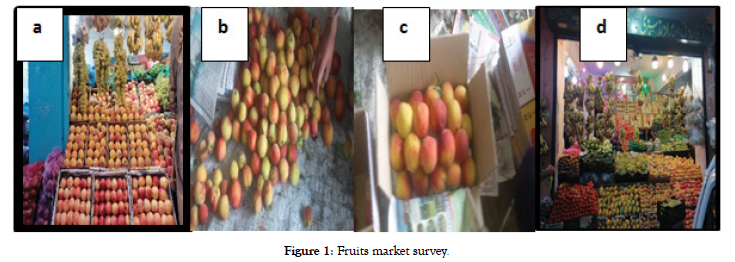Indexed In
- Open J Gate
- Genamics JournalSeek
- Academic Keys
- JournalTOCs
- CiteFactor
- Ulrich's Periodicals Directory
- Access to Global Online Research in Agriculture (AGORA)
- Electronic Journals Library
- Centre for Agriculture and Biosciences International (CABI)
- RefSeek
- Directory of Research Journal Indexing (DRJI)
- Hamdard University
- EBSCO A-Z
- OCLC- WorldCat
- Scholarsteer
- SWB online catalog
- Virtual Library of Biology (vifabio)
- Publons
- Geneva Foundation for Medical Education and Research
- Euro Pub
- Google Scholar
Useful Links
Share This Page
Journal Flyer

Open Access Journals
- Agri and Aquaculture
- Biochemistry
- Bioinformatics & Systems Biology
- Business & Management
- Chemistry
- Clinical Sciences
- Engineering
- Food & Nutrition
- General Science
- Genetics & Molecular Biology
- Immunology & Microbiology
- Medical Sciences
- Neuroscience & Psychology
- Nursing & Health Care
- Pharmaceutical Sciences
Research Article - (2021) Volume 12, Issue 7
Plant Essential Oils Were Used to Characterize and Control Post-Harvest Fungal Infections in Peaches
Gull-e-laala Khan1*, Gulshan Irshad1, Farah Naz1 and Ashfaq Ahmed Hafiz22Department of Horticulture, PMAS Arid Agriculture University Rawalpindi, Pakistan
Received: 08-Jul-2021 Published: 29-Jul-2021, DOI: 10.35248/2157-7471.21.12.567
Abstract
Post-harvest fungal pathogens are major threat to food industry, deteriorating the quality of perishable fruits from handling, transportation and distribution to consumption. Half of the production of peaches lost annually due to the prevalence of post-harvest fungal diseases worldwide. The present study was intensively designed to investigate the post-harvest fungi associated with peach. The most common spoilage fungi isolated and identified were Aspergillus niger, Rhizopus stolonifera and Penicillium expansum. The highest percentage of infection was recorded in fruits with street sellers, local fruit shops and the smallest one was recorded in storage houses after harvesting. In-vitro experiment against post-harvest spoilage fungi was directed by using plant essential oils extracted from native herbs by Clevenger type apparatus. Essential oils are natural biocide against postharvest rotting of fresh produce. The antifungal activity of oils was increased with an increase in the concentrations of oil. Amongst the plant essential oils used, Trigonella foenum-gracum at highest concentration (0.10%) caused maximum inhibition in the mycelial growth and spore germination of Aspergillus niger and Rhizopus stolonifer followed by the essential oils (Thymus vulgaris and Eucalyptus globulus) at (10%). Essential oils as natural compounds are highly degradable with no accumulation in plants and can replace hazardous environmental deteriorating artificial fungicides. These findings strengthen the possibility of using plant essential oils as an eco-friendly alternative component to chemicals for enhancing shelf-life of peach fruit.
Keywords
Spoilage fungi; Aspergillus niger; Rhizopus stolonifera; Penicillium expansum; Fennel; Thyme; Eucalyptus
Introduction
Postharvest fungal diseases are among signiï¬cant factors that limit the storage period and marketing life of peaches, and even result in serious economic losses worldwide [1]. Post-harvest diseases caused by fungal pathogens aggravate severe losses upto 40% every year (FAO, 2019). Perishable fruits due to their low pH, higher moisture content and nutrient composition are more susceptible to attack by pathogenic fungi, which cause decaying and make them unfit for consumption [2]. Additionally, the diseases caused by fungal pathogens in harvested fresh fruits are considered as one of the most serious losses of production at the postharvest and consumption levels [3]. Peach (Prunus persica) is grown commercially in regions between 25° and 45° latitude above and below the equator and is a one of the popular summer fruit crops of temperate and sub-tropical regions. Peach is cultivated in Pakistan in KPK, Balochistan, AJK and few areas of Punjab. Peach is a highly perishable fruit and is attacked by several diseases at various stages (Pre-harvest, post-harvest). Major fungal pathogens (Aspergillus spp., Penecillium spp., Rhizopus spp., Botrytisspp., etc.) are responsible for causing post-harvest rotting. The loss figures due to post-harvest damage of perishable fruits is reported 28- 42% worldwide, and 15-50% in less industrialized countries [4]. This means that half of what is produced never reaches the consumer for whom it was grown, and the effort and money required to produce it are lost forever.
A number of strategies have been adapted to manage post-harvest diseases worldwide [5]. Concomitant development of fungicide resistance by postharvest decay fungi has stimulated efforts to develop alternative systems of disease control for agricultural products [6]. During the last decades there has been a global awareness that excessive and improper use of chemical fungicides is hazardous to the health of humans, animals, and the environment, therefore an extensive research for environmentally safe and easily biodegradable bio-fungicides is being carried out.
The biological activity of essential oils and their constituents can act as fungistatic and fungicidal agents, depending, for instance, on the concentrations used. Nevertheless, suppression of spore production by essential oils could play a major role in limiting the spread of the pathogen, by lowering the spore load in the storage atmosphere and on surfaces [7]. Generally, essential oils are considered, safe for both the environment and human health, so interest in their use as antimicrobial agents for fresh commodities has increased in the last few years. Essential oils of plant origin have been found non-injurious to the treated food commodities, human health, and environment and to enhance the shelf- life and quality of the products.
The present study aimed to pinpoint the major post-harvest spoilage fungi effecting peach and to determine the effectiveness of plant essential oils to enhance the shelf- life of peach fruit in District Poonch AJK.
Materials and Methods
A survey of post-harvest fruit markets in Swat, Rawalpindi and District Poonch AJK was conducted randomly during the month of April-June (Figure 1). Peach fruits with different rotting symptoms were collected periodically from markets and street sellers. The temperature recorded during sample collection was 28-32°C from from Swat, 35-39°C from Rawalpindi and 25-29°C from District Poonch AJK.
Disease incidence was calculated in Table 1 by following formula:

Figure 1. Fruits market survey.
| Pathogen | Normal Fruit | Mean | Injured Fruit | Mean | ||||
|---|---|---|---|---|---|---|---|---|
| Swat | Rawalpindi | Poonch | Swat | Rawalpindi | Poonch | |||
| Aspergillus niger | 42 | 33 | 27 | 51.0 | 21 | 63 | 79 | 81.5 |
| Rhizopus stolonifer | 51 | 40 | 34 | 62.5 | 19 | 54 | 68 | 70.5 |
| Penicillium expansum | 55 | 42 | 37 | 71.1 | 17 | 50 | 65 | 61.2% |
Table 1: Fungal infection percentages of normal and injured Peach fruits by 02 major pathogenic isolates of rot fungi (N=100).
The samples were brought in laboratory and were kept in isolated environments for proper growth of the fungal hyphae and conditions were maintained in moist chamber at room temperature for 7-10 days. All the fruit samples were subjected to repeated isolations. Isolations were done by taking small portions of rotted tissues aseptically from the peach fruits and transferred to potato dextrose agar (PDA) medium. Pure colony cultures were obtained by sub-culturing the fungal growth in separate Petri plates containing the same medium. The pathogens were identified by their morphological and cultural characteristics [8].
Pathogenicity test was conducted for the confirmation of highly virulent isolates. Asymptomatic fruit samples were surface sterilized with running tap water. Injuries were made with the help of sterile needle to fruits upto 5 mm diameter and place in a disc of fungal isolates, whereas control fruit samples were inoculated with distilled water. Fruit samples were placed in a thermo-pole box (3 fruits per box) and stored at 25°C for 3 days. Three replicates were used in each treatment. The disease was scored in accordance of modified scale. Identification of the disease and the pathogen was done following Koch’s postulates. Different parameters such as symptoms caused by these fungi on the healthy peach fruits, cultural characteristics of the pathogens and microscopic studies of the pathogens were studied [9].
Management experiment was conducted by using different plant essential oils that were extracted by selected native herbs and plant material from Poonch District (Fennel oil, Eucalyptus and Thyme oil). The essential oils were isolated by hydro-distillation through Clevenger apparatus. Fresh plant parts including leaves and rhizome were cut into small pieces and then thoroughly washed with purified water. The plant material was then placed in the round-bottom flask of the Clevenger Apparatus. The ratio between the plant material and water in the flask was maintained as 1:3. Water was heated to produce steam that carried the most volatile fractions of the fragrant material with it. The steam was then chilled using a condenser and the resulting distillate was collected. The essential oil was found to float on the top of the hydrosol the distilled water component and was separated off. The extracted oils were dehydrated by the addition of anhydrous sodium sulphate, followed by thorough shaking and standing for 6–8 h and filtration. The concentration of plant essential oil was prepared by using Tween 20 along with sterilized water. Treatments were applied at concentrations (0.04%, 0.06%, 0.08% and 0.10%) along with control by using disc diffusion method. All the experiments were conducted in triplicate.
The essential oils with different concentrations were dissolved in water-diluted lacquer prior to spraying on all internal surfaces of the packaging boxes after diluting the lacquer. Lacquer with different concentrations of essential oil inclusion complex was sprayed on cardboard boxes and were left until complete absorption
Results
The symptoms on peach fruits appeared as cottony, fluffy, initially white and then turning black. Small water-soaked areas that become soft and rotten (Figure 2). Lesions were circular, soft and watery and were soon covered with masses of shiny, erect sporangiophores that appear at break in the fruit skin (Figure 3). Some of the symptoms were soft light-colored spot that spread rapidly across the surface and deeply into the fruit tissue with blue to green coremial structure appearing on the surface (Figure 4). Pathogens were identified after microscopy as Aspergillus niger, Rhizopus stolonifer and Penicillium expansum.
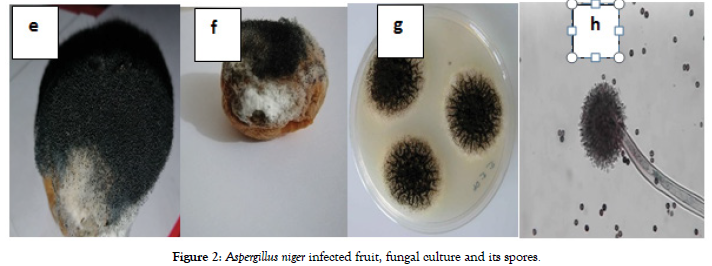
Figure 2. Aspergillus niger infected fruit, fungal culture and its spores.
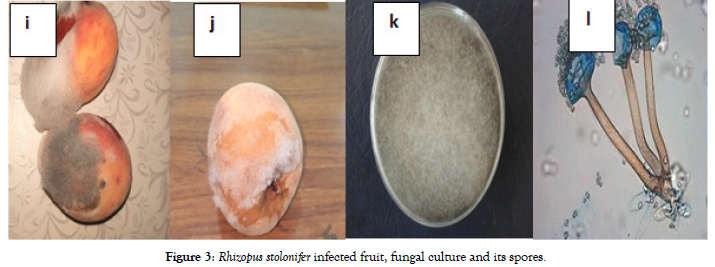
Figure 3. Rhizopus stolonifer infected fruit, fungal culture and its spores.
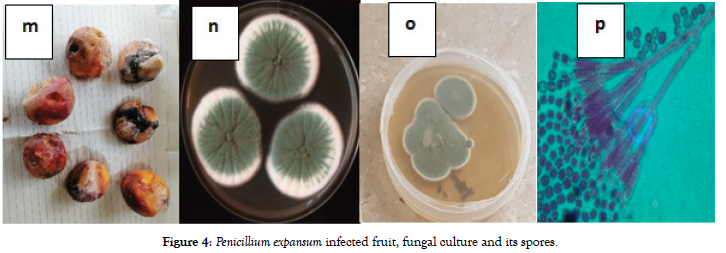
Figure 4. Penicillium expansum infected fruit, fungal culture and its spores.
Among the isolated pathogens it was reported that Aspergillus was by far the most common genus affecting peach. It appeared on 92.5% of peach fruits. Aspergillus niger was the dominant specie on the tested fruits. The highest incidence (90%) of Aspergillus niger was observed on peach fruits collected from District Poonch AJK followed by (83.54%) District Rawalpindi and minimum incidence (47.89%) was recorded from peach collected from Swat. Rhizopus stolonifer was observed 74.3% (Poonch), 69.6% (Rawalpindi) and 51.3% (Swat). Penicillium expansum recorded 69.1% from(Poonch), 60.9% (Rawalpindi) and 48.5% (Swat) (Table 2).
| Peach | Swat 28-32° |
Rawalpindi 35-39° |
Poonch 25-29° |
|---|---|---|---|
| Street Sellers | 47.9% | 56.1% | 74.3% |
| Fruit Markets | 33.0% | 60.9% | 62.% |
Table 2: Percentages of fungal infection of Peach fruits collected from different places at different temperatures (N=100).
Disc diffusion method was applied for management of isolated post-harvest decaying pathogens with different concentrations of plant essential oils. Sterilized filter paper discs were dipped in different concentrations of essential oils and were placed on isolated fungi on petri plates. Growth inhibition zone of spoilage fungi was recorded after seven days interval (Table 3). Control of Aspergillus niger, Rhizopusstolonifer and Penicillium expansum causing rotting of peach with plant essential oils at different concentrations were evaluated under in vitro conditions for their effect on the mycelial growth and spore germination of the test fungi. The Fenugreek oil bring about significant reduction in mycelial growth of Aspergillus niger, Rhizopus stolonifer andPenicillium expansum, being most effective at higher concentrations (0.10%) reducing mycelial growth by 91% followed by Thyme oil (83%) and Eucalyptus oil (65%). Lower concentrations of the essential oils also bought about momentous inhibition in the mycelial growth but to a lesser extent (Figure 5).
| Growth Inhibition Zone | |||||||
|---|---|---|---|---|---|---|---|
| Fennel Oil | Conc. | Thyme Oil | Conc. | Eucalyptus Oil | Conc. | Control | Conc. |
| 3.1cm | 0.04% | 2.5cm | 0.04% | 2cm | 0.04% | 0 | 0.04% |
| 7.4cm | 0.06% | 6.7cm | 0.06% | 6.1cm | 0.06% | 0 | 0.06% |
| 10.1cm | 0.08% | 9.3cm | 0.08% | 8.4cm | 0.08% | 0 | 0.08% |
| 13.9cm | 0.10% | 11.2cm | 0.10% | 10.9cm | 0.10% | 0 | 0.10% |
Table 3: Different concentrations of essential oil inhibiting growth zone of isolated pot-harvest fungi by disc diffusion method.
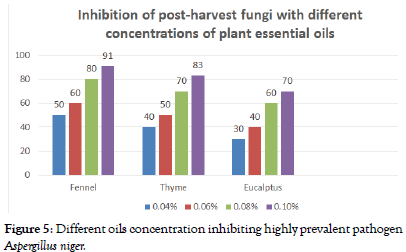
Figure 5. Different oils concentration inhibiting highly prevalent pathogen Aspergillus niger.
Cardboard boxes with small internal lining based on encapsulated fenugreek essential oil with maximum concentration (10%) enhance the shelf life of peaches from 5 to 10 days following the concentration (0.8%). On the other hand eucalyptus and thyme essential oil enhance the shelf life of peaches from 5 to 9 days at the concentration (10%).
Discussion
After conducting an extensive survey of the orchards and post-harvest fruit markets 300 samples were collected periodically from post-harvest markets. Post-harvest diseases render heavy losses to perishables during transit and storage. Higher water contents, nutrient composition and pH of most of the perishables make them capable of supporting the growth of a number of micro- organisms.
In this respect, Akinmusire [10] and Chukwuka et al. [11] revealed that fruits can be affected by a wide range of post-harvest microorganisms such as fungi which have a serious threat to production and shelf life of fruits. Spoilage attributes to any change in the condition of food making it less palatable or even toxic as these alterations may be accompanied by changes in taste, smell, appearance and commodity shelf-life.
The essential oils are thought to play a role in the plant defense mechanism against phytopathogenic microorganisms and are attributed towards inhibition of post-harvest spoilage microorganisms.
Previously, other researchers such as Lopez, et al. [12] also checked the effect of essential oils against decaying fungal pathogens and find them effective against fungal rotting.
Rotten peach fruits were treated with different concentrations of fennel, thyme and eucalyptus essential oils which inhibit the growth of Aspergilus niger, Rhizopus stolonifer and Penicillium expansum post-harvest fungi. Increasing oils concentration also increased oils efficiency for control of post-harvest spoilage fungi of peach fruits in the present study. These results are similar to the results obtained with tomato, where Ragab et al. [13] found that the vapor of lemon grass oil at 6 ml/L significantly suppress postharvest decay of tomato fruits caused by post-harvest Fusarium oxysporum. Our results are an agreement with the results of other researchers, who stated that application of essential oils after post-harvest stages act as physical barrier against different rotting stages.
Therefore, the use of essential oils as antimicrobial agents can be an interesting field of investigation as the toxicity of essential oils to human is zero, and their degree of volatility allows their use for fumigation for active packaging.
Conclusion
Peach is one of the major cash crops and income’s source of the growers. This research provides a factual picture of major decaying post-harvest fungi affecting peach in Pakistan. Natural plant products with low mammalian toxicity are promising alternatives to synthetic fungicides for postharvest decay control of fruits and vegetables. In conclusion, fenugreek oil with strong fungitoxicity, thermostable nature, long shelf-life, fungicidal efficacy against test fungi, lower MIC in comparison to synthetic fungicides and the potential to withstand high inoculum density, is an excellent bio-fungicide. Essential oils as natural compounds are highly degradable with no accumulation in plants and can replace hazardous environmental deteriorating artificial fungicides. The use of active packaging essential oil inclusion complex extended the shelf-life of peach. These findings strengthen the possibility of using plant essential oils as an alternative bio-component to chemicals for inhibiting growth of spoilage fungi and enhancing shelf-life of peach.
REFERENCES
- Kader AA. Increasing food availability by reducing postharvest losses of fresh produce. Int. Postharvest Symp. Acta Hort. 2005;682:2169â??2178.
- Moss MO. Mycotoxin review-1. Aspergillus and penicillium. Mycologist. 2002;16(3):116-119.
- Spadaro D, Droby S. Development of biocontrol products for postharvest diseases of fruit: The importance of elucidating the mechanisms of action of yeast antagonists. Trends Food Sci Tech. 2016;47:39-49.
- Food and Agriculture Organization of the United Nations. Global Food Losses and Food Waste: Extent, Causes and Prevention; FAO: Rome, Italy. 2016.
- Wisniewski M, Droby S, Norelli J, Liu J, Schena L. Alternative management technologies for postharvest disease control: The journey from simplicity to complexity. Postharvest Biology and Technology. 2016;122:3-10.
- El-Sheikh A, Baraka MA, El-Sayed A. The effectiveness of fumigants and biological protection of peach against fruit rots. AJAS. 2000;31(5):19-31.
- Tzortzakis NG, Economakis CD. Antifungal activity of lemongrass (Cympopogon citratus L.) essential oil against key postharvest pathogens. Innov Food Sci Emerg. 2007;8(2):253-258.
- Gilman JC. A Manual of Soil Fungi. Iowa State University Press, Ames. 2008:382.
- Javed S, Javaid A, Anwar W, Majeed RA, Akhtar R, Naqvi SF. First report of Botrytis bunch rot of grapes caused by Botrytis cinerea in Pakistan. Plant Disease. 2017;101(6):1036.
- Akinmusire OO. Fungal species associated with the spoilage of some edible fruits in Maiduguri Northern Eastern Nigeria. Adv Environ Biol. 2011;5(1):157-161.
- Chukwuka KS, Okonko IO, Adekunle AA. Microbial ecology of organisms causing pawpaw (Carica papaya L.) fruit decay in Oyo State, Nigeria. American-Eurasian J Toxicol Sci. 2010;2(1):43-50.
- Lopezâ?Reyes JG, Spadaro D, Gullino ML, Garibaldi A. Efficacy of plant essential oils on postharvest control of rot caused by fungi on four cultivars of apples in vivo. Flavour Fragr J. 2010;25(3):171-177.
- Ragab MM, Ragab MA, El-Nagar S. Effect of lemon grass oil on post-harvest decay of tomato fruits. Egypt J Phytopathol. 2001;29(1):59-68.
Citation: Khan G, Irshad G, Naz F, Hafiz AA (2021) Plant Essential Oils Were Used to Characterize and Control Post-Harvest Fungal Infections in Peaches. J Plant Pathol Microbiol. 12:567.
Copyright: © 2021 Khan G, et al. This is an open-access article distributed under the terms of the Creative Commons Attribution License, which permits unrestricted use, distribution, and reproduction in any medium, provided the original author and source are credited.


